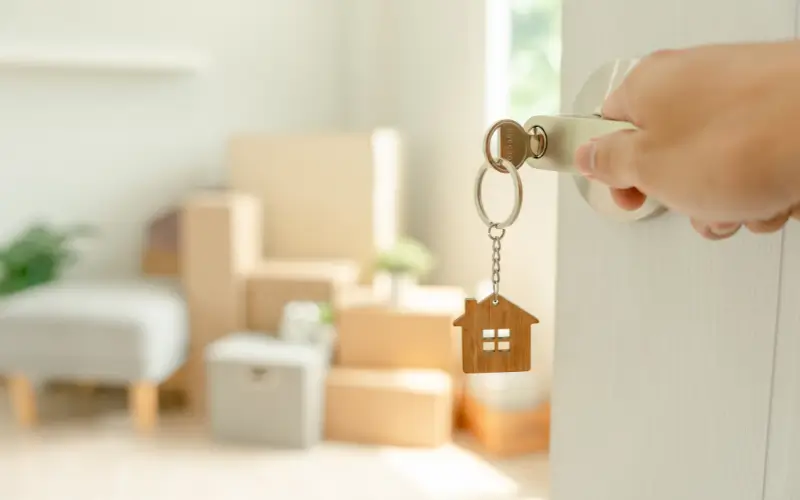Moving day brings new habits and street names, but the first daybreak within empty walls needs more than just delivered boxes. It needs practical tools and consistent preparation that keeps the health, time, and mood of everyone living under the roof safe. Clear priorities, such as having active water lines, functioning smoke alarms, and meals available, turn empty rooms into safe living spaces. This avoids late-night store runs, lowers the risk of accidents, and keeps spending in check when energy is still running low after weeks of packing and planning.
Keys and Utilities Should Be Safe
Before moving into a new house, make sure electricity, gas, and water are already running so the space feels safe and comfortable. Service orders should be sent to providers at least a week in advance, with start dates set for dawn on arrival day. When the first bill comes, dated pictures of the first meter readings show that the charge is reasonable. They also protect household money from back-dated estimates that come from previous tenants or clerical mistakes that show up months later. Duplicate door keys with clear labels prevent people from accidentally locking themselves out. Smart-lock batteries let contractors use temporary codes without giving up permanent access. From the first hour, extra fobs, mailbox keys, and garage remotes should be kept in a designated envelope in a safe place.
Stage Cleaning Tools and Safety Gear Early
Dust lurks in vent grates, cabinet corners, and closet tracks, waiting to settle on dishes and linens unless microfiber cloths, mild disinfectant, and vacuum hoses are kept in the family car instead of getting buried in the moving van. Thick garbage bags collect plastic wrap and food waste, keeping floors clear. A ready-to-grab caddy should contain a flashlight, additional batteries for the smoke alarms, a small fire extinguisher, gloves, screwdrivers, and wrenches.
Prepare Priority Rooms First
First, color-coded markings on boxes reveal where each room is, which helps packers get to the right doors quickly and keeps corridors clear for rolling wardrobes and strollers. Clear boxes labeled “First Night” are placed on certain tables. They store chargers, extension cables, towels, and blankets so that kids and tired parents don’t have to look frantically when it becomes dark. Collapsible shelving solutions in closets turn heaps of sweaters into dust-free stacks while you wait for permanent cabinets to be measured. Within minutes, door hooks may store coats, purses, and dog leashes. This prevents clutter and stumbling on bare flooring. Pets and small children feel peaceful in the early structure because they can see and smell things they know among the echoing walls. This makes their transition easier, long before the artwork and books are put in their final places.
Stock the Kitchen with Immediate Essentials
Peanut butter, crackers, single-serve packets of cereal, and canned beans will help lower takeout expenses until the pantry shelves are replenished. Surge protectors on coffee makers, electric kettles, and slow cookers to cook hands-free in other locations. Resealable containers avoid leaks, preserve leftovers, and keep ants off the surfaces. All day, a row of reusable water bottles keeps you hydrated and focused as heavy furniture is moved in. Before leaving, fill up reusable water bottles at the old house. This will keep you hydrated if plumbers take hours to flush silt from pipes that aren’t known to them, which will help you think clearly while making important choices about where to put furniture.
Set up Personal Comfort Packs
Each resident gets a clear zip bag with a toothbrush, soap, medicine, pajamas, and new clothing. This lets them go to bed straight away, even if their clothing boxes remain sealed until the weekend. Noise-reducing curtains on tension rods prevent streetlamps and early morning light in bedrooms. This enables you to sleep well and have more energy the next day. Young brains may relax in unexpected places with their favorite storybooks, stuffed animals, and battery-powered sound makers. These things help with travel tiredness and echoing hall acoustics. Small power banks keep phones charged so they may be used for navigation, delivery confirmations, and calls to faraway family who want to know how things are going. Basic skincare lotion, adhesive bandages, and painkillers are all you need to prevent dry skin, paper cuts, and tight muscles without going to the pharmacist. Quick comfort helps stabilize emotions, so you may unpack gradually without feeling worn out.
Conclusion
Getting through a settlement takes more than strong backs and labeled boxes. It also requires careful planning of utilities, quick cleaning and safety procedures, organized rooms, cooking supplies, and personal comfort packages that keep morale and rest high. Each part cuts down on hidden expenditures like having to shop in an emergency, damaging appliances, and becoming angry, leaving more time to enjoy discovering new communities and meeting pleasant neighbors. So, with careful planning, moving day goes from a frantic rush to a confident walk into a welcome house that is well grounded.




